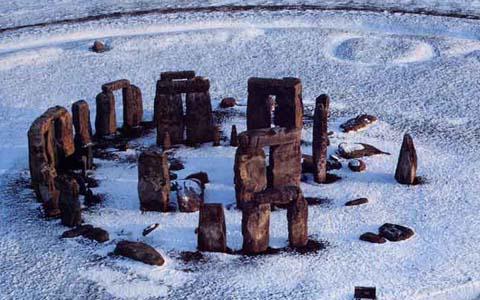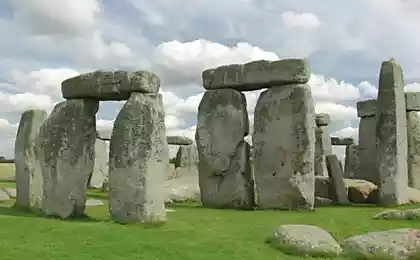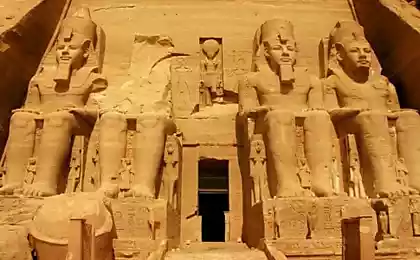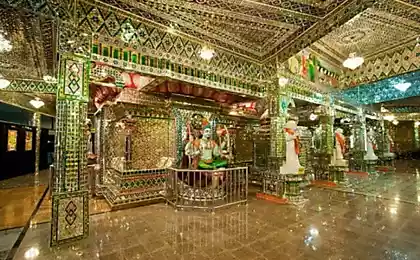863
Stonehenge: Outer Temples?

The grand megalithic structure at Stonehenge - it has come down to us from time immemorial monument mysterious past of religion and science. For our contemporaries, it remains a puzzle, a miracle of architecture and the epitome of creativity in people. So what is it? Sacred burial ground or a prehistoric observatory? To discern the outlines of the original Stonehenge is possible today, although many do not have the stones in place.
The mystical aura. Stonehenge - one of the most visited archaeological sites in the world. The mystical atmosphere of Stonehenge attracts a lot of tourists here, especially during the summer solstice, which has already expressed concern about the damage caused to the monument. As a result, the site was fenced and public access to the stones is limited.
Standing in an open field in the middle of Salisbury Plain in Wiltshire, Stonehenge is a mystery that seems to be as old as the world.
Strange concentric stone circles that make up this building - the result of the change of archaeological periods occur over thousands of years. Monuments associated end of the Stone and Bronze Ages beginning, was built in three or four stages for approximately 1,500 years. However, the main work was done between 1800 and 1400 years BC. e. But what remains from Stonehenge today - it is only a pale shadow of its former magnificence. More than half of rocks or fallen or gone underground or disappeared in some other way.
Construction began around 2800 years BC. e. (Some experts believe that in 3800), when it was dug a circular ditch and formed earthen embankment was made 56 seizures, subsequently called "mines Aubrey" in honor of their discoverer in the XVII century John Aubrey. Then these pits were grouted. It is believed that the first set there is a giant stone Hilstoun standing in front of the earthworks are still left in its original place. Two rings shafts have a ring and the ring Z, which may have been dug with astronomical purposes, are located between the "mines Aubrey" and massive stone rings in the center.
Around 2100 BC Welsh was brought to 80 blocks of blue sandstone of which were piled two concentric circles. Later, instead of them it was built a ring of huge sandstone monoliths 30, called sarsenis. Within this ring were two horseshoe-shaped structure - composed of five foreign Sarsenova dolmens (two standing stones - menhirs and one horizontal, lying on them as the crossbar), and internal - of the 19 cromlechs (hewn slabs of blue sandstone). The only instrument available to the builders was the hoe, made of antlers deer. That is why the architectural monuments are simply amazing.
The Saxons called the megalith Stonehenge, which means "hanging stone." A medieval scribes mentioned it under the poetic name of "Toy giant." Although most scientists agree that this place is associated with religious worship, its true purpose, nothing was known. For example, who lived in the XVII century architect Inigo Jones argued that the stones - is the ruins of a Roman temple. But in the XVIII and XIX centuries was the common point of view that the stone circle is nothing but a temple of Druids who worshiped the sun and sacrificed people. This is hardly true, because Stonehenge was built at least 1,000 years before the rise of Druidic cult.
SARS outer circle, reaching a height of five meters and weighing about 26 tons each, were dragged delivered from Marlborough Downs, located about 32 km from Stonehenge. They are carefully adjusted to each other so that the vertical columns and cross member fixedly connected by hinges. Obtained in the Cambrian Mountains in the south-west Wales blue sandstone slabs, weighing up to 4 tons, were probably transported on rafts around the Welsh coast, then up the River Avon, and finally pulled out of the land.
Considering the amount of earthworks, available in the area where there is the highest concentration in Britain burial mounds, most modern archeologists believe that Stonehenge was a ceremonial cemetery.
More recently, astronomers claim that they supposedly "deciphered" the stones, we put forward the hypothesis that Stonehenge - a prehistoric computing mechanism, astronomical calendar or astronomical calculator. This follows from the fact that the arrangement of the stones seems to have a direct relation to the movement of the sun, moon, planets and their ever-changing interference. Thus, a unified theory that would explain the mysterious and legendary past Stonehenge, yet.























